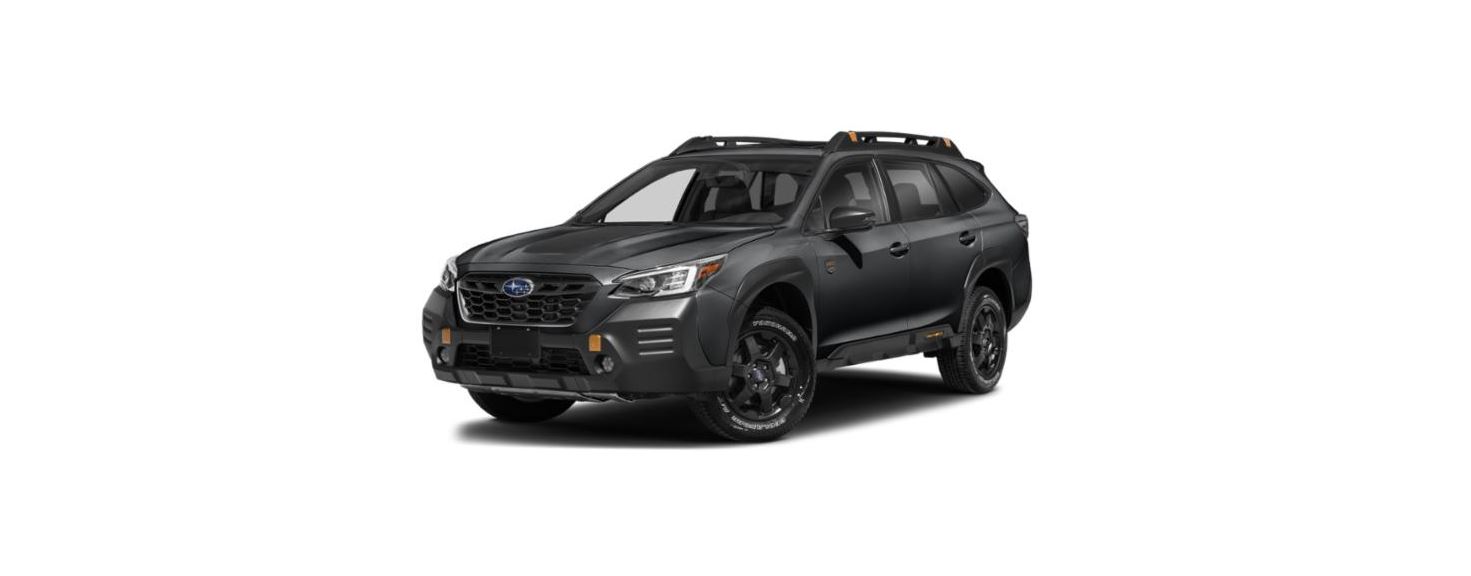2022 Subaru Outback Loading Your Vehicle
 Loading Your Vehicle
Loading Your Vehicle
WARNING
Never allow passengers to ride on a folded rear seatback, in the trunk, or in the cargo area. Doing so may result in serious injury.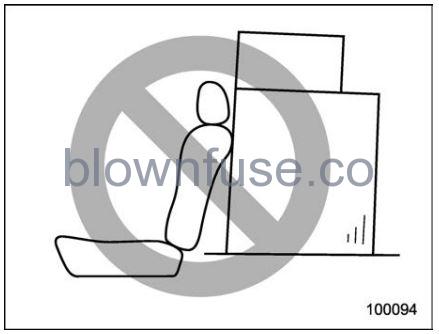
WARNING
- Never stack luggage or other cargo higher than the top of the seatback because it could tumble forward and injure passengers in the event of a sudden stop or accident. Keep luggage or cargo low, as close to the floor as possible.
- When you carry something inside the vehicle, secure it whenever you can to prevent it from being thrown around inside the vehicle during sudden stops, sharp turns or in an accident.
- Do not pile heavy loads on the roof. These loads raise the vehicle’s center of gravity and make it more prone to tip over.
- Secure long items properly to prevent them from shooting forward and causing serious injury during a sudden stop.
- Never exceed the maximum load limit. If you do, some parts on your vehicle can break, or it can change the way your vehicle handles. This could result in loss of control and cause personal injury. Also, overloading can shorten the life of your vehicle.
- Do not place anything on the rear shelf behind the rear seatback (Legacy) or the extended cargo equipped). Such items could tumble forward in the event of a sudden stop or a collision. This could cause serious injury.
CAUTION
Do not carry spray cans, containers with flammable or corrosive liquids or any other dangerous items inside the vehicle.
NOTE
For better fuel economy, do not carry unneeded cargo
Vehicle Capacity Weight
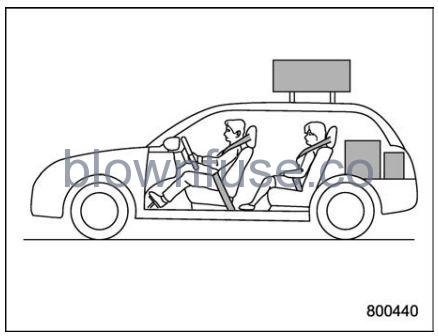
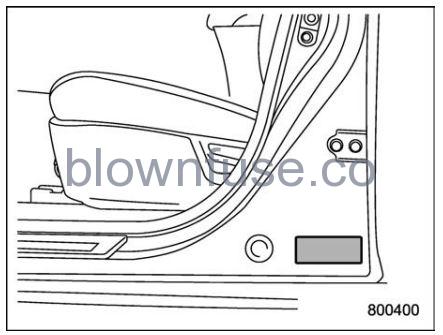
The load capacity of your vehicle is determined by weight, not by available cargo space. The maximum load you can carry in your vehicle is shown on the vehicle placard attached to the driver’s side door pillar. It includes the total weight of the driver and all passengers and their belongings, any optional equipment such as a trailer hitch, roof rack or bike carrier, etc., and the tongue load of a trailer
GVWR and GAWR (Gross Vehicle Weight Rating and Gross Axle Weight Rating)
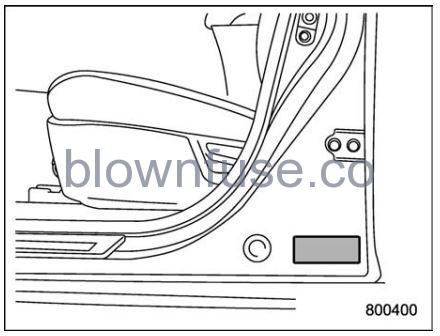
- The certification label attached to the driver’s side door pillar shows GVWR (Gross Vehicle Weight Rating) and GAWR (Gross Axle Weight Rating).
- The GVW (Gross Vehicle Weight) must never exceed the GVWR. GVW is the combined total of weight of the vehicle, fuel, driver, all passengers, luggage, any optional equipment, and trailer tongue load. Therefore, the GVW changes depending on the situation.
- In addition, the total weight applied to each axle (GAW) must never exceed the GAWR. The front and rear GAWs can be adjusted by relocating luggage inside the vehicle.
- Even if the total weight of your luggage is lower than the vehicle capacity weight, either front or rear GAW may exceed the GAWR, depending on the distribution of the luggage.
- When possible, the load should be evenly distributed throughout the vehicle. If you carry heavy loads in the vehicle, you should confirm that GVW and front and rear GAWs are within the GVWR and GAWR by putting your vehicle on a vehicle scale, found at a commercial weighing station.
- Do not use replacement tires with a lower load range than the originals because they may lower the GVWR and GAWR limitations. Replacement tires with a higher load range than the originals do not increase the GVWR and GAWR limitations.
Roof Molding and Crossbar (Legacy)
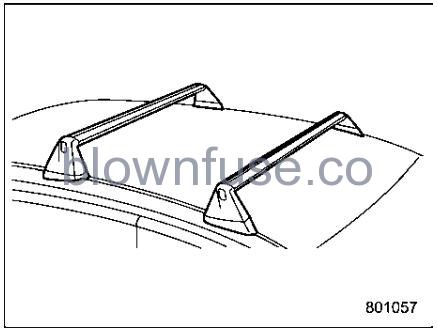
CAUTION
- For cargo carrying purposes, the roof molding must be used together with a roof crossbar kit and the appropriate carrying attachment. Otherwise, damage to the roof or paint or a road hazard due to loss of cargo could result.
- When using the roof crossbar kit, make sure that the total weight of the crossbars, carrying attachment and cargo does not exceed the maximum load limit. Overloading may cause damage to the vehicle and create a safety hazard.
- Do not install a roof tent on the vehicle. Doing so may damage the vehicle and create a safety hazard. SUBARU warranties do not cover vehicle damage resulting from use of a roof tent.
Installing carrying attachments on the crossbars
When installing any carrying attachments such as the load carriers, crossbars, bike carriers, ski carriers, kayak carriers, cargo basket, etc., follow the manufacturer’s instructions for the load capacity and make sure that the attachments are securely installed. Use only attachments designed specifically for the crossbars. Before operating the vehicle, make sure that the cargo is properly secured on the attachment.
NOTE
Remember that the vehicle’s center of gravity is altered with the weight of the load on the roof, thus affecting the driving characteristics. Drive carefully. Avoid rapid starts, hard cornering and abrupt stops. Crosswind effects will be increased.
Removal and installation of the crossbars
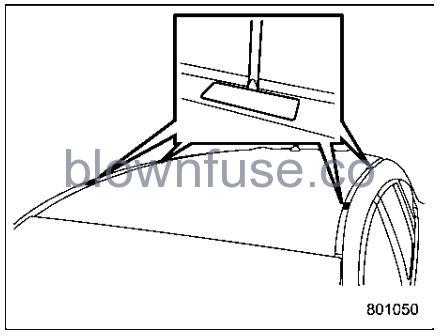
Each of the two roof moldings has two mounting points for crossbars. Each mounting point is fitted with a cover. Use a screwdriver to open the covers. When installing the crossbars on the roof molding, follow the manufacturer’s instructions.
Roof Rails with Integrated Crossbars (Outback)
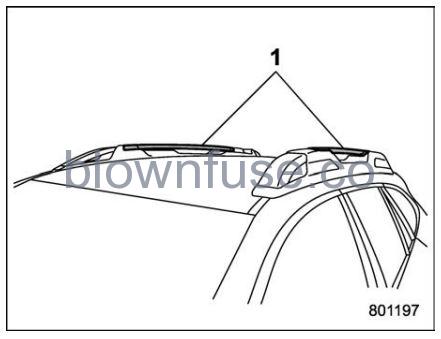
- Integrated crossbars
CAUTION
- For cargo carrying purposes, the crossbars must be extended across the roof and locked into the roof rails. Cargo must be attached to the crossbars using genuine SUBARU accessory crossbar attachments. The crossbars must never be used independently to carry cargo on the roof. Otherwise, damage to the roof or paint or a dangerous road hazard due to loss of cargo could result.
- When loading cargo on the crossbars, using the genuine SUBARU accessory crossbar attachments, make sure the total weight of the crossbar attachments, and loaded cargo, does not exceed the maximum load limit of 150 lbs (67.5 kg). Overloading may cause damage to the vehicle and create a safety hazard.
- Be careful not to damage the vehicle body when passing the rope through the front and rear holes of the roof rails.
- Do not install a roof tent on the vehicle. Doing so may damage the vehicle and create a safety hazard. SUBARU warranties do not cover vehicle damage resulting from use of a roof tent.
- The crossbars must be extended across the roof and locked into the roof rails to carry cargo on the roof. Cargo can only be carried on the crossbars using the genuine SUBARU accessory crossbar attachments.
- When you carry cargo on the roof using the crossbars and a carrying attachment, never exceed the maximum load limit explained in the following. You should also be careful that your vehicle does not exceed the Gross Vehicle Weight Rating (GVWR) and front and rear Gross Axle Weight Rating (GAWR). For information on loading cargo into or onto your vehicle, refer to “Loading Your Vehicle” FP435.
- The maximum load limit of the cargo and carrying attachment must not exceed the allowable load limit described in the Owner’s Manual of a genuine SUBARU carrying attachment. Place the heaviest load at the bottom, nearest the roof, and evenly distribute the cargo. Always properly secure all cargo.
Installing carrying attachments on the crossbars
When installing any carrying attachments such as the load carriers, crossbars, bike carrier, ski carrier, kayak carrier, cargo basket, etc., follow the manufacturer’s instructions of the load capacity and make sure that the attachments are securely installed. Use only attachments designed specifically for the crossbars. Before operating the vehicle, make sure that the cargo is properly secured on the attachment.
NOTE
- Remember that the vehicle’s center of gravity is altered with the weight of the load on the roof, thus affecting the driving characteristics. Drive carefully avoid rapid starts, hard cornering and abrupt stops. Crosswind effects will be increased.
- Restore the bars to the original position when the bars are not used as crossbars
How to use as crossbars
CAUTION
- Do not raise the bar higher than necessary. The base of the bar may be damaged.
- Be careful not to contact the bars while sliding them. Otherwise, the bars may be scratched or the latch portions may be damaged.
- Do not slide the bar more than necessary when sliding the bar. The base of the bar may be damaged.
- Do not allow the bar to fall on or contact the roof panel or the moonroof when sliding the bar. Otherwise, the roof panel may be dented or the glass of the moonroof may be damaged.
- Be careful hands do not become pinched when operating the crossbar. Hands becoming pinched could result in injury.
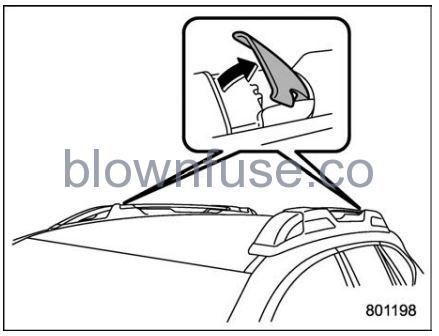
- Pull out the integrated crossbars from the roof rail holders by pulling up the covers.
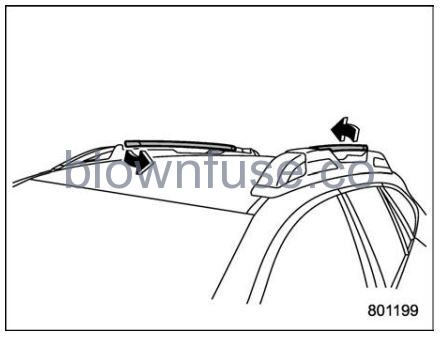
- Slide the bars in the direction shown in the illustration.
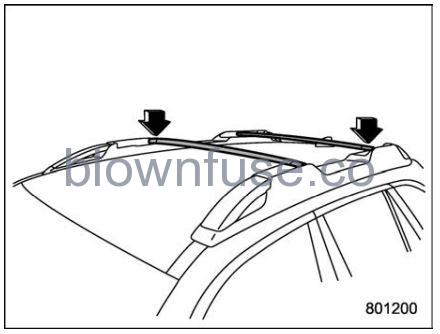
- Install the bars into the holders.
- Make sure that the latches are fitted securely.
How to change the position of the crossbar
WARNING Carefully read the warning label attached to the roof rail
You can change the position of the rear crossbar. To change the position, perform the following procedure.
- Take out the torque wrench from the underfloor storage compartment
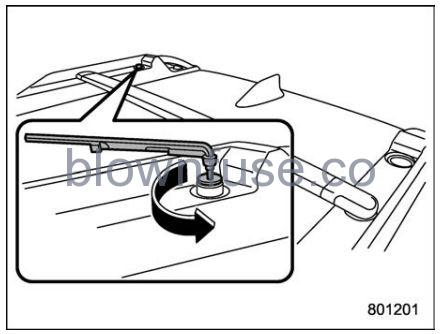
- Remove the plastic plug of the roof rail holder by using the torque wrench
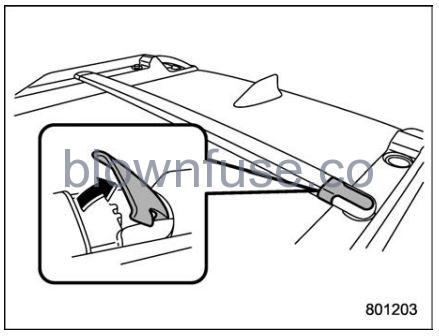
- Remove the bolt of the crossbar by using the torque wrench and pull this side out.
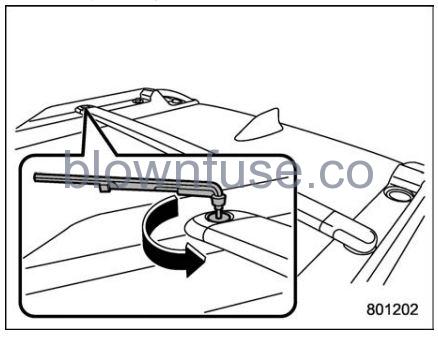
- Pull out the other side of the crossbar from the roof rail holder by pulling up the cover.
- Install both ends of the crossbar into the other holders.
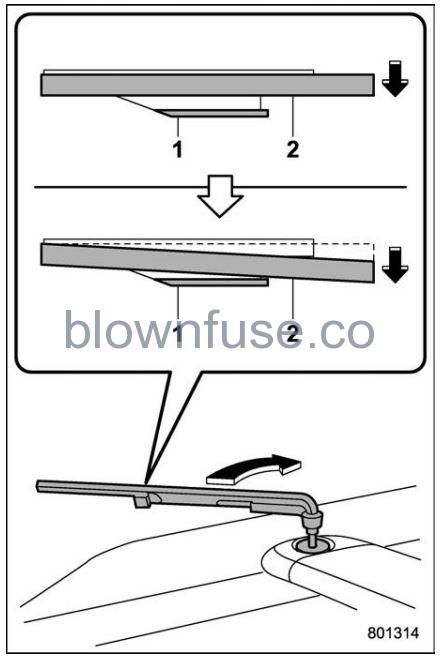
- Guide plate
- Torque wrench
- Using the torque wrench, tighten the crossbar bolts until the torque wrench hits the guide plate
NOTE
The tightening torque is approximately 8.9 + 2.2 lbf·ft (12 + 3.0 N·m, 1.2 + 0.3 kgf·m).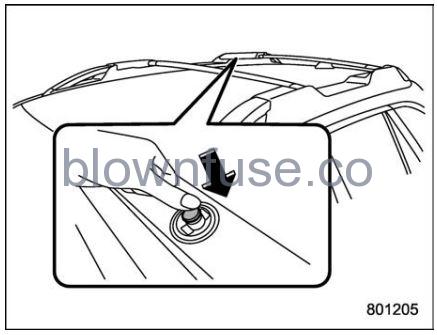
- Install the plastic plug by pushing it into the hole until it is fully seated
How to re-stow bars
CAUTION: Do not use the bars as roof rails when the bars are stowed.
- Check that the rear crossbar is stowed in the front side holder
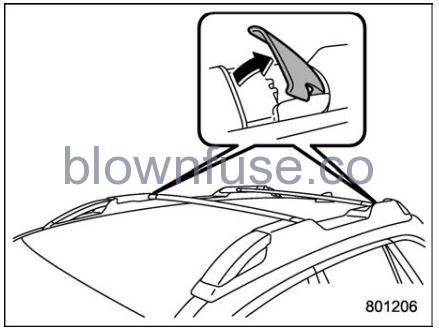
- Pull out the crossbars from the roof rail holders by pulling up the covers.
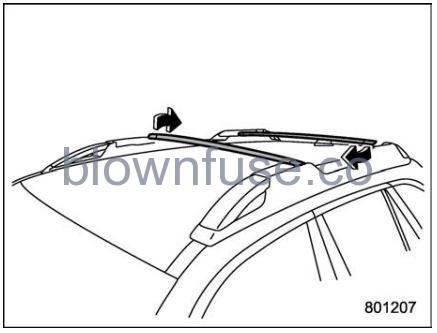
- Slide the bars in the direction shown in the illustration.
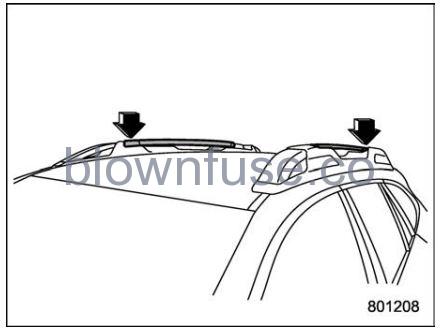
- Install the bars into the holders.
- Make sure that the latches are fitted securely
Roof Rails with Ladder Type (Subaru Outback Wilderness)
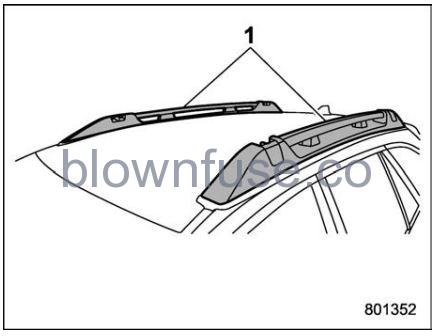
- Roof rails
Cargo can be carried on the roof after securing the roof crossbars to the roof rails and installing the appropriate carrying attachments. When installing the roof crossbars and the carrying attachments, follow the manufacturer’s instructions. The roof rail system is designed to carry loads (cargo, roof crossbars and carrying attachments) of no more than 220 lbs (100 kg). Be sure not to exceed your vehicle’s GVWR and GAWR.
CAUTION
- When using the carrying attachments, make sure that the total carrying load of the cargo, roof crossbars and carrying attachments does not exceed 220 lbs (100 kg). Overloading may cause damage to the vehicle. Read the manufacturer’s instructions and pay attention to not exceed the load limit of the parts.
- For cargo carrying purposes, the roof rails must be used together with the SUBARU recommended roof crossbars and any appropriate carrying attachment that may be needed. The roof rails must never be used alone to carry cargo. Otherwise, damage to the roof or paint, or a dangerous road hazard due to loss of cargo could result.
NOTE
- Remember that the vehicle’s center of gravity is altered with the weight of the load on the roof, thus affecting driving characteristics.
- Drive carefully. Avoid rapid starts, hard cornering and abrupt stops. Crosswind effects will be increased
Rope hooks (attached to the roof rails)
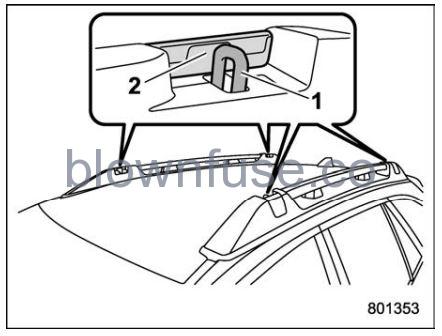
- Rope hooks
- Covers
CAUTION
- When you use the rope hooks, always secure the rope at all four hook points.
- The maximum load capacity is 176 lbs (80 kg) per hook.
- The cover cannot be removed.
- Do not tighten the rope excessively. Otherwise, it may lead to damage to the vehicle body or cargo.
- Check that the rope is not loose before driving the vehicle.
- When you use the rope hooks, never exceed the maximum load limit.
Roof Tent (Subaru Outback Wilderness)
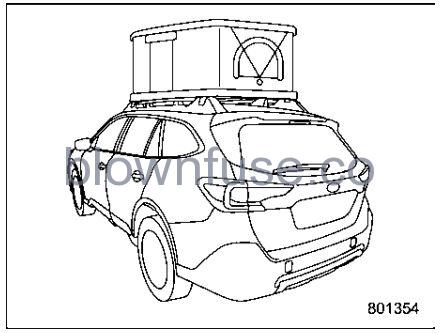
WARNING Adding weight to the vehicle’s roof can adversely affect the handling, braking, and rollover resistance. The vehicle must never be driven with a total roof rail load in excess of 220 lbs (100 kg).
CAUTION
- The roof rail load limit for stationary vehicles (700 lbs (317 kg)) applies only when the vehicle is parked and the load is evenly distributed left/right and front/ rear and the roof crossbars and roof tent are tightly secured to the vehicle. If these conditions are not met, the loan limit will be lower.
- The maximum load limit of the roof crossbars must be obtained from the manufacturer or retailer of the roof rack. When driving the vehicle, the maximum roof rail load is 220 lbs (100 kg) or the crossbar load limit (whichever is lower).
Roof tents may be used under certain conditions at your own risk.
When driving the vehicle
The total weight on the roof rails, including the roof crossbars and roof tent, must not exceed the vehicle’s roof rail load of 220 lbs (100 kg), evenly distributed.
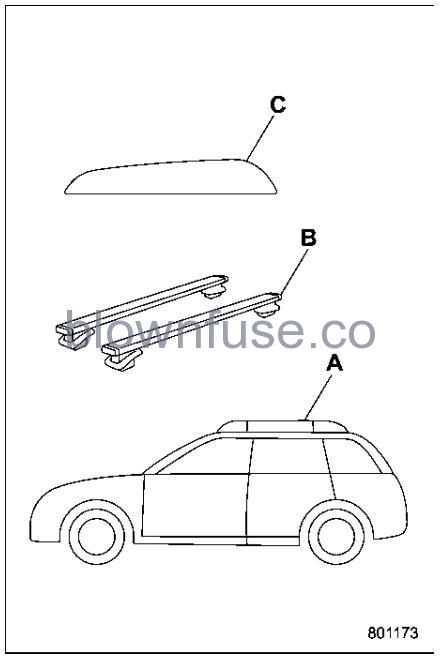
- A: Roof rails
- B: Roof crossbars
- C: Roof tent
- B + C < 220 lbs (100 kg)
When the vehicle is parked on level ground
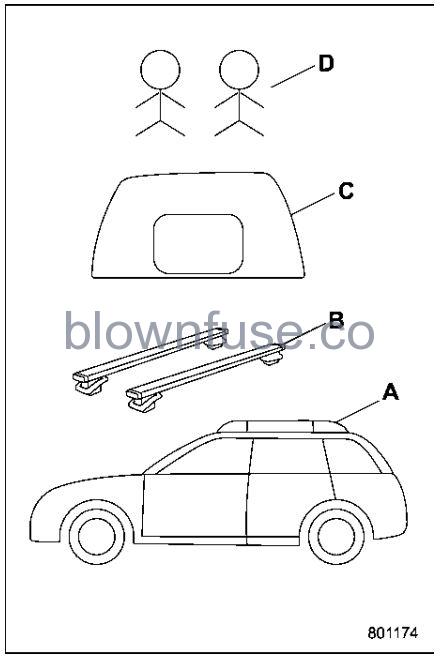
- A: Roof rails
- B: Roof crossbars
- C: Roof tent
- D: Occupants in the roof tent
The total weight on the roof rails – including the roof crossbars, roof tent, and all occupants and contents in the roof tent – must not exceed either the vehicle’s roof rail load limit (700 lbs (317 kg)), evenly distributed, or the load limit of the roof crossbars, whichever is lower
Load limit of the roof rail (A). B + C + D < 700 lbs (317 kg)
Exceeding this load limit could cause damage to the vehicle or racking system. The vehicle must never be driven with occupants in the roof tent. Before the vehicle is driven, occupants and cargo must be removed from the roof tent and the roof rail load must be restored to within the roof rail load limit of 220 lbs (100 kg). Refer to the user manual that accompanied the roof tent for important safety information and instructions on the proper installation and use of the tent.
